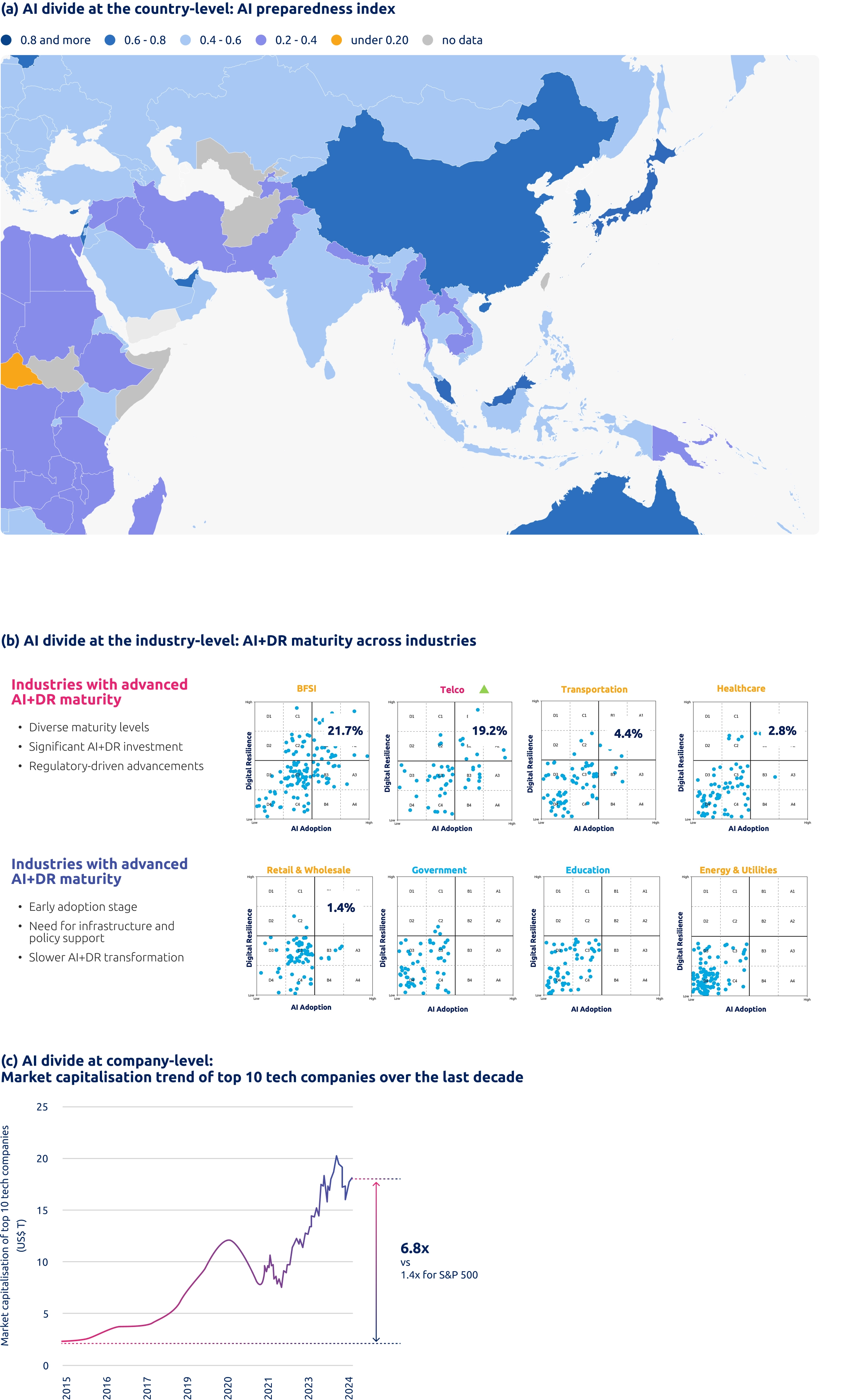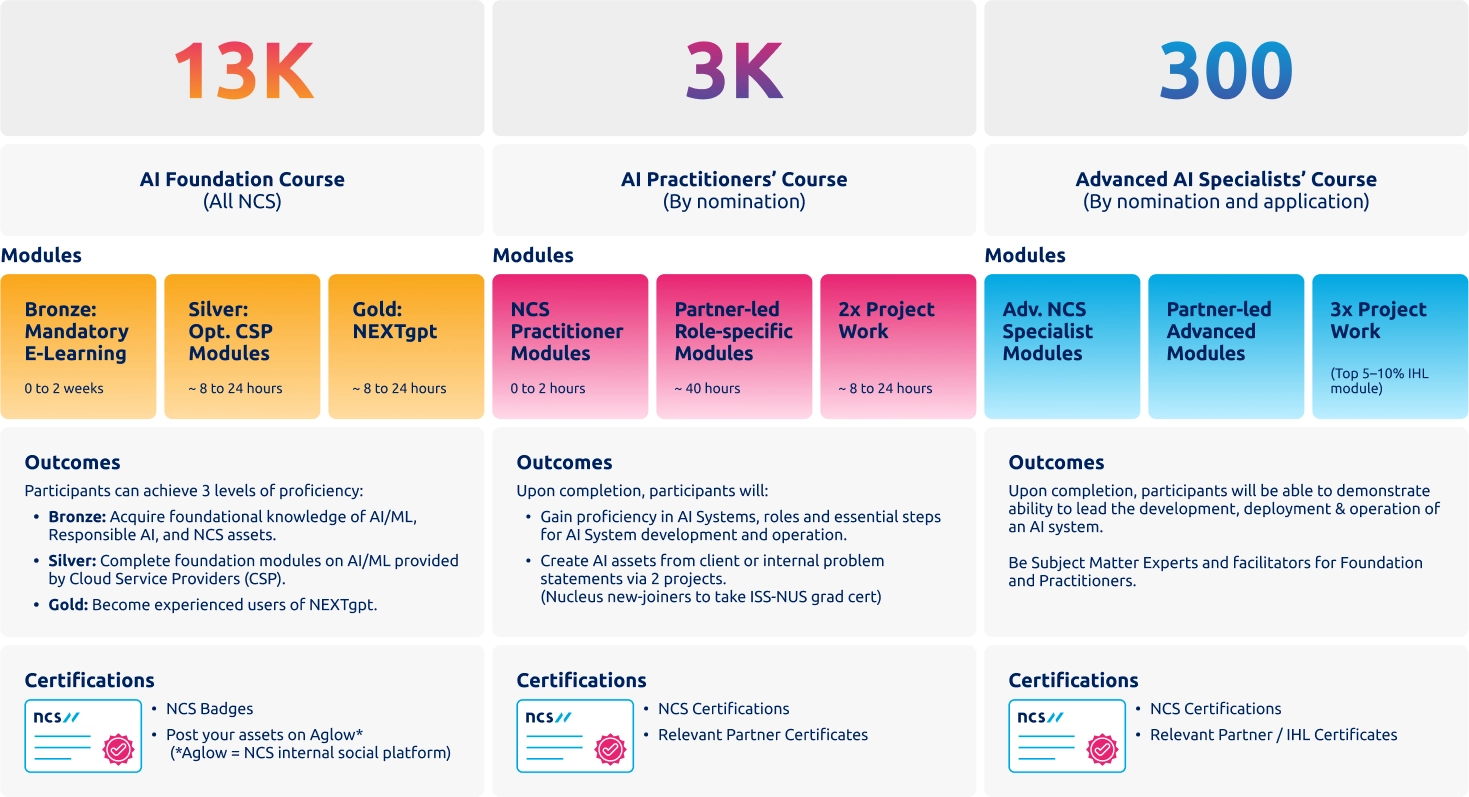Published: Oct 17, 2025
Uplifting people with AI skills
Artificial intelligence brings enormous potential, but it also risks deepening divides—between countries, industries, companies, and within organisations. The question isn’t whether AI will create or displace jobs, but how unevenly its benefits will be distributed.
At NCS, we see closing this “AI divide” as a strategic imperative. Our 13K–3K–300 AI Enablement Program was designed to democratise AI skills, ensure inclusivity, and translate adoption into real-world performance gains.
Key takeaways
- AI adoption is uneven across countries, industries, and companies. Some nations and sectors move quickly because they have strong digital foundations, while others face structural challenges in talent, infrastructure, and governance. This risks widening inequality at a global level.
- Internal divides within organisations are just as critical. Even when AI is available, not every employee has equal access to tools, training, or the ability to benefit from them. Divides in access, use, and performance can slow down transformation.
- Closing divides is a strategic capability, not just an HR exercise. Skills uplift cannot be treated as compliance or one-off training. Organisations that take a structured and inclusive approach position themselves for sustainable competitiveness and innovation.
- NCS’s tiered 13K–3K–300 Program shows scale and depth. By combining universal access with targeted practitioner training and advanced leadership development, we ensure that AI becomes part of daily work across 13,000 employees.
- True impact comes from embedding AI into workflows. Transformation is measured not by tool rollout, but by how decision-making, productivity, and innovation improve in practice.
AI divide – the emerging fault line
Like any transformative trend, the rise of AI brings both opportunity and challenge. The most pressing risk is not mass job loss, but the uneven distribution of benefits.
- Country level: National AI readiness differs dramatically. Nations with strong governance, infrastructure, and digital maturity will accelerate, while others fall behind.
- Industry level: Digitally advanced sectors like finance and ICT are positioned to lead, while industries with weaker digital foundations face greater barriers.
- Company level: A handful of firms dominate the market, generating extraordinary value with relatively small workforces—creating wealth concentration but limited broad employment benefits.
This emerging “fault line” will widen without deliberate action, threatening long-term competitiveness, workforce stability, and societal cohesion.

Figure 1. AI divides at the country, industry and company levels have emerged.
Learnings from the digitalisation era: avoiding internal divides
The digitalisation era taught us that divides don’t only occur across nations or industries—they also occur within organisations. These internal divides can determine whether technology adoption succeeds or stalls.
Three divides are particularly important:
- Access divide
Employees often lack the tools or data needed to work effectively with AI. A Microsoft survey shows that 41% of non-management staff feel they lack the technological tools to perform their roles. - Use divide
Even with tools in hand, skills gaps remain a barrier. The World Economic Forum predicts that 39% of core skills will change by 2030, yet less than half of the workforce has begun upskilling. - Performance divide
Higher-skilled roles benefit disproportionately, while routine roles risk displacement. Unless organisations actively measure and support outcomes, AI’s benefits may not be equitably shared.
To close these gaps, leading organisations will:
- Ensure inclusive tool access across all roles and geographies
- Offer role-sensitive training tied to real work tasks
- Track performance outcomes—not just deployment metrics
By doing so, workforce transformation moves from being an HR task to a core strategic capability.
Case study: NCS AI Enablement Programme
In July 2024, NCS launched the AI Enablement Programme to uplift skills across our 13,000-strong workforce. Its 13K–3K–300 framework ensures transformation reaches every employee, while also creating pathways for practitioners and leaders to deepen expertise.
- Access: All staff were provisioned with NCSgpt, our internal generative AI tool, to support learning and productivity in daily tasks.
- Use: Over 3,000 practitioners were enrolled in role-specific pathways, tailored to consulting, development, data pipeline management, and infrastructure modernisation.
- Performance: Employees are encouraged and expected to apply skills in live projects—reshaping workflows, modernising IT operations, and delivering differentiated solutions for clients.
The programme ensures AI transformation is measured not by technology rollout, but by how decisions, processes, and productivity improve across the enterprise.

Figure 2. NCS AI Enablement Programme at a glance.

Figure 3. Role-based training for NCS' AI Practioners, supported by partner technology company's training resources.
Sustainable transformation starts with people
The rise of AI sharpens divides across economies and workforces. The true risk is not disruption itself, but uneven opportunity and capability. Organisations that fail to close access, use, and performance divides risk eroding competitiveness, resilience, and employee trust.
NCS’s 13K–3K–300 AI Enablement Program demonstrates how inclusivity, structure, and outcome-driven learning can close divides at scale. By embedding AI into daily work and aligning training to real responsibilities, NCS has shown that skills uplift is not an afterthought—it is the foundation for sustainable, enterprise-wide adoption.
References
Bughin, J., & van Zeebroeck, N. (10 September, 2018). The promise and pitfalls of AI. Retrieved from World Economic Forum: https://www.weforum.org/stories/2018/09/the-promise-and-pitfalls-of-ai/
Ichino, A., Pacelli, L., & Vecchi, M. (2023). Digging into the digital divide: Workers’ exposure to digitalisation. Institute of Labor Economics (IZA), Bonn. Retrieved from https://docs.iza.org/dp14649.pdf
IMF DataMapper. (June 25, 2024). AI Preparedness Index (AIPI). Retrieved from International Monetary Fund: https://www.imf.org/external/datamapper/datasets/AIPI
Microsoft. (October 20, 2022). Technology unlocks a new future for frontline. Retrieved from Microsoft WorkLab: https://www.microsoft.com/en-us/worklab/work-trend-index/technology-unlocks-a-new-future-for-frontline
Najeh, M., Rho, E., & Ha, H. (2021). A comprehensive review of digital divide literature: Methodological and thematic trends. Global Knowledge, Memory and Communication. doi:https://doi.org/10.1108/GKMC-05-2021-0075
World Economic Forum. (April 21, 2025). The Future of Jobs Report 2025. Retrieved from World Economic Forum: https://www.weforum.org/publications/the-future-of-jobs-report-2025/
